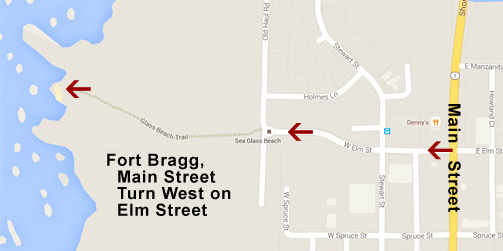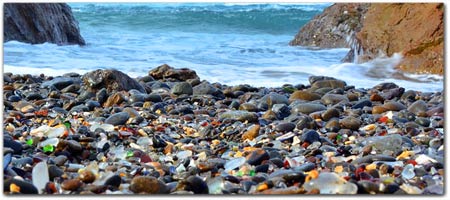Since green, brown and clear (white) are the most common glass that was disposed of, the majority pieces are those colors. Occasionally, you'll see pottery chips and rarer colors of glass.
Only a few items were actually stored in red, blue, lavender, purple or pink glass containers. Should you see these colors, they most likely came from these items.
SAPPHIRES - BLUE GLASS
For instance, very rare Cobalt Blue, the "sapphire" of the beach, came from such apothecary items as Milk of Magnesia, Vick's Vapo Rub, Noxema, Nivea, and Bromo Seltzer bottles, along with some prescription bottles and perfumes
RUBIES ~ RED GLASS
The extremely rare red pieces, or "rubies" of the beach, might come from perfume bottles, the tail lights on old automobiles, lantern and traffic light lenses, or even some types of old beer bottles, like the bottles made by Anchor Hocking for Schlitz Beer in the 1950's.
GEM GLASS
Pinks, lavenders, purples, lime greens and other rare shades came from things like perfume bottles and art glass. Many lavenders and pinks come from what was originally clear glass that was clarified with magnesium (lavender) or selenium (pink). The glass has to be clarified with these minerals because the sand from which glass is made is actually amber in color. Over time the sun causes the magnesium and selenium to oxidize, creating the lavender and pink colors.
COMMON SEA GLASS
Greens, browns, and aquas come from beer and soda bottles, and nearly every other source, like Clorox Bleach jugs, shampoos, etc.
FIRE GLASS
And sometimes, like in the old town dumps in Fort Bragg, California, the sea glass is also passed through fires and becomes "Fire Glass", the rarest of sea glass, and often has "inclusions" (things inside), just like, or better than, precious gems.
IMPURITIES
In fact, gemological terms like "inclusions", "clarity", "color", "facets" and "purity" also pertain directly to sea glass, except that inclusions and "impurities" are bad in gemstones and often excellent in sea glass, and a lot of people prefer their sea glass "frosted" instead of clear (unless there are "inclusions") and no one would think of buying a cloudy diamond, except to HIDE an inclusion!












